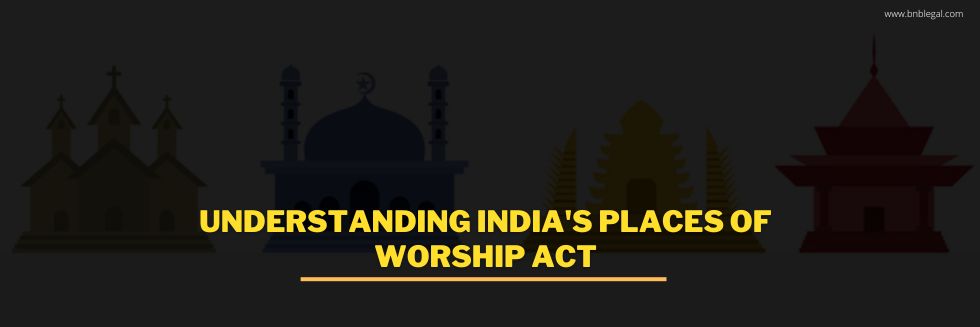“When I think of a place of worship, I think of a place where one can sit and be reminded of all the things that are important outside our individual lives. To express spirituality, the architect has to think of the original material of architecture, space, and light.” Richard Meier
Introduction
The preamble to the constitution of India declares India to be a, “sovereign, socialist, secular and democratic and republic” nation. Article 25 of the Constitution of India provides every person with the freedom to practice, propagate and profess religion within the limits that do not harm public order, morality, and health. It is no brainer that India is seen as the best exhibit when it comes to the topic of “religion.” Whenever we talk about a superior power, there is always a place associated with it. However, it almost never comes to our mind how that land/place/area came to be or how law influenced it. “The Places of Worship (Special Provisions) Act,1991” is a statute that deals with the everlasting houses of worship.
Key Provisions Of Places Of Worship Act
The Places of Worship Act which has an overriding effect over other enactments was enacted on September 18th 1991 with the purpose to preserve the nature and character of the places of worship as they stood and existed on August 15th 1947. Dr. Malini Bhattacharya, the former member of the Parliament, said that August 15 was chosen as the date as it is the day India became a free, democratic, and sovereign state in which there was no state religion and all religions were treated the same. Consequently, Section 3, prohibits the conversion of “any place of worship of any religious denomination or any section thereof into a place of worship of a different section of the same religious denomination or of a different religious denomination or any section thereof.” The most crucial amongst all the definitions provided under Section 2 of the Act is the definition of ‘place of worship’ which is defined as “a temple, mosque, gurudwara, church, monastery or any other place of public religious worship of any religious denomination or any section thereof, by whatever name called.”
Section 4 of the act bars the jurisdiction of the courts against any suit, appeal, or other proceeding from being entertained on or after the effective date of this Act in any court, tribunal, or other authority regarding the conversion of the religious identity of any place of worship. Section 4 (3) provides the exceptions to the provision contained in Section 4 as: any place of worship that has been designated as an ancient and historical monument, an archaeological site, or a remnant by any other law or the Ancient Monuments and Archaeological Sites and Remains Act of 1958; any proceedings that were adjudicated, resolved, or otherwise dealt with by a court, tribunal, or other body before the effective date of this Act; any dispute over connected matters that was settled amicably by the parties before the proceeding began; any earlier conversion of such a location to a religious or secular purpose that was permitted with the owner’s consent; any addition or change made to a place of worship before the start date that cannot be contested under any statute of limitations that was in effect at the time. Section 6 the penal provision which punishes anyone who acts in contravention of Section 3 of the act along with providing punishments for anyone who attempts, abets or is a party to the criminal conspiracy of such contravention.
Section 5 is another provision which provides an exception which observes, “Nothing contained in this Act shall apply to the place or place of worship commonly known as Ram Janma Bhumi-Babri Masjid situated in Ayodhya in the State of Uttar Pradesh and to any suit, appeal or other proceeding relating to the said place or place of worship.”
Controversies Related Places Of Worship Act
The Places of Worship (Special Provision) Act, 1991 was enacted for the humanitarian purpose of protecting the meaningfulness behind the places of worship, regardless of which religion or sect it belongs to. It shows respect to every religion and the places that people associate with them. The government while standing in support of the act, has said that the act is the way forward in securing religious harmony in the country. However, like every other statute, this piece of legislation has attracted its fair share of criticism and controversies from people.
Questions have been raised on the constitutional validity of the Act as it prohibits judicial review as provided under Sections 4 and 5 of the Act, which is one of the many facets that promotes the supremacy of the Constitution. Moreover, there also have been a variety of criticisms in relation to the Act being violative of Article 25, Article 26 and Article 29 of the Constitution which stand at the core of the idea of secularism. These criticisms have not failed in reaching the court of law, yet the court has in the following mentioned cases, upheld the act saying:
M Siddiq (D) Thr Lrs vs Mahant Suresh Das & Ors (2021) SCC 1: This case was filed by the legal heirs of M Siddiq, who was one of the original plaintiffs in the Babri Masjid case. The petitioners challenged the constitutional validity of the Places of Worship Act, 1991. The Supreme Court upheld the constitutional validity of the Act, stating that it was a “legislative measure to promote communal harmony and to maintain the status quo as on 15 August 1947”.
Amish Devgan vs Union of India (2020) 14 SCR 198: This case was filed by Amish Devgan, a lawyer, who challenged the constitutional validity of Section 5 of the Places of Worship Act, 1991. Section 5 exempts the Ram Janmabhumi-Babri Masjid site from the provisions of the Act. The Supreme Court dismissed the petition, stating that Section 5 was a “temporary measure” that was necessary to maintain peace and order in the wake of the Babri Masjid demolition.
Whether or not this act is repealed or amended will be seen in the days to come. The complex web of questions on the constitutional validity of the act and its actuality today are likely to continue in the coming years. However, arguments in support of the act being necessary to maintain peace and order and the protection of the religious integrity of the country, are not meagre.
This article is written and submitted by Khushi Verma during her course of internship at B&B Associates LLP. Khushi is a 3rd year B.A.LL.B.(Hons.) student at UILS, Panjab University, Chandigarh.









